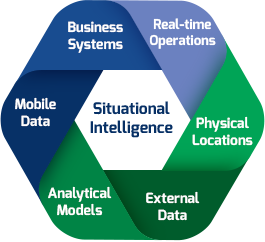 Space-Time Insight offers situational intelligence applications to help you make faster, more-informed decisions, using real-time visual analytics software to provide actionable insight into big data. In the interview below, Space-Time Insight’s Senior Vice President of Marketing and Product Management Steve Ehrlich discusses how situational intelligence incorporates and applies data and understanding from six different domains to assist organizations in solving complex, big data problems:
Space-Time Insight offers situational intelligence applications to help you make faster, more-informed decisions, using real-time visual analytics software to provide actionable insight into big data. In the interview below, Space-Time Insight’s Senior Vice President of Marketing and Product Management Steve Ehrlich discusses how situational intelligence incorporates and applies data and understanding from six different domains to assist organizations in solving complex, big data problems:
- Business Systems
- Real-time Operations
- Physical Locations
- External Data
- Analytical Models
- Mobile Data
Read on for more important insights from Space-Time Insight!
insideBIGDATA: How does Situational Intelligence play an important role with big data?
Steve Ehrlich: By definition, situational intelligence implies several things:
First, “situation” suggests an understanding of what has happened in the past, what is happening now and what might happen in the future.
Next, since situations are inherently complex, they typically involve multiple assets, resources and events, many of which may exist outside the control of an organization. The ability to correlate disparate data from many different systems and data sources is required to comprehend the scope and impact of situations.
Third, to acquire “intelligence” requires an understanding of what, when, why, how and where something happened or might happen. Implicit in this understanding are the concepts of spatial analysis (e.g. “what is nearby?”), temporal analysis (e.g. “how has it evolved?”) and nodal analysis (e.g. “what is the impact on other assets/resources?”).
Situational intelligence incorporates and applies data and understanding from six different domains to assist organizations in solving complex, big data problems. These domains are:
Situational intelligence systems commonly comprise three components:
- Data gathering and normalizing: Organizations own and access many separate sources of IT, operations (OT), and external data. These sources need to be brought together into a single environment and normalized so that they can be combined and correlated.
- Data correlation and analysis: Once data from appropriate sources is gathered and normalized, various data sets are correlated and analyzed within specific business contexts to solve problems and uncover new opportunities.
- Data visualization: Rendering correlated and analyzed information in a combination of geospatial and tradition analytical formats gives users a fast and intuitive way to recognize what decisions must be made and what actions must be taken.
insideBIGDATA: How situational intelligence is being used today?
Steve Ehrlich: Here are just a few examples of how situational intelligence is being used today:
- Anticipating and responding rapidly to the infrastructural impact of a severe storm to reduce service disruptions
- Balancing the variability of customer demand with supply in real-time to optimize asset and resource utilization
- Identifying performance issues over time and taking proactive steps to maintain assets or rectify situational threats
- Correlating machine data with external systems and events (such as fire, weather and vegetation) to identify system failures before they occur
- Performing root-cause analysis to determine why assets malfunctioned and triggering remedial actions as a result
- Prioritizing tasks based on greatest financial impact or risk reduction
- Predicting the extent of service outages and feeding that information proactively to customers to reduce service inquiries
- Optimizing service delivery routes and times to reduce operational costs and improve customer service
- Understanding the downstream or upstream network and service level impacts of an equipment failure
Sign up for the free insideBIGDATA newsletter.





Speak Your Mind